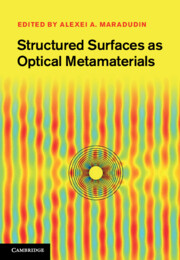Book contents
- Frontmatter
- Contents
- List of contributors
- Preface
- 1 Physics of extraordinary transmission through subwavelength hole arrays
- 2 Resonant optical properties of nanoporous metal surfaces
- 3 Optical wave interaction with two-dimensional arrays of plasmonic nanoparticles
- 4 Chirality and anisotropy of planar metamaterials
- 5 Novel optical devices using negative refraction of light by periodically corrugated surfaces
- 6 Transformation of optical fields by structured surfaces
- 7 Surface electromagnetic waves on structured perfectly conducting surfaces
- 8 Negative refraction using plasmonic structures that are atomically flat
- 9 Anomalous transmission in waveguides with correlated disorder in surface profiles
- 10 Cloaking
- 11 Linear and nonlinear phenomena with resonating surface polariton waves and their applications
- Index
- Plate section
- References
4 - Chirality and anisotropy of planar metamaterials
Published online by Cambridge University Press: 01 June 2011
- Frontmatter
- Contents
- List of contributors
- Preface
- 1 Physics of extraordinary transmission through subwavelength hole arrays
- 2 Resonant optical properties of nanoporous metal surfaces
- 3 Optical wave interaction with two-dimensional arrays of plasmonic nanoparticles
- 4 Chirality and anisotropy of planar metamaterials
- 5 Novel optical devices using negative refraction of light by periodically corrugated surfaces
- 6 Transformation of optical fields by structured surfaces
- 7 Surface electromagnetic waves on structured perfectly conducting surfaces
- 8 Negative refraction using plasmonic structures that are atomically flat
- 9 Anomalous transmission in waveguides with correlated disorder in surface profiles
- 10 Cloaking
- 11 Linear and nonlinear phenomena with resonating surface polariton waves and their applications
- Index
- Plate section
- References
Summary
Introduction
In recent years it has emerged that planar metamaterials offer a vast range of custom-designed electromagnetic functionalities. The best known are wire grid polarizers, which are established standard components for microwaves, terahertz waves, and the far-infrared. They are expected to be of increasing importance also for the near-infrared [1] and visible light [2]. Equally well developed are frequency selective surfaces [3–6], which are used as filters in radar systems, antenna technology [7], broadband communications, and terahertz technology [8, 9]. However, the range of optical effects observable in planar metamaterials and the variety of potential applications have only become clear since metamaterials research took off in 2000 [10]. Wave plate [11, 12] as well as polarization rotator and circular polarizer [13–15] functionalities have been demonstrated in metamaterials of essentially zero thickness. Traditionally, such components are large as they rely on integrating weak effects over thick functional materials. Polarization rotation has also been seen at planar chiral diffraction gratings [16, 17] and thin layered stereometamaterials [18, 19]. Electromagnetically induced transparency (EIT) [20–24] and high quality factor resonances [20] have been observed at planar structured interfaces. And finally, new fundamental electromagnetic effects leading to directionally asymmetric transmission of circularly [25–29] and linearly polarized waves have been discovered in planar metamaterials.
Planar metamaterials derive their properties from artificial structuring rather than atomic or molecular resonances, and therefore appropriately scaled versions of such structures will show similar properties for radio waves, microwaves, terahertz waves, and, to some extent, in the infrared and optical spectral regions where losses are becoming more important.
- Type
- Chapter
- Information
- Structured Surfaces as Optical Metamaterials , pp. 94 - 157Publisher: Cambridge University PressPrint publication year: 2011
References
- 5
- Cited by

